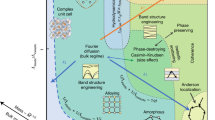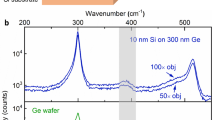Abstract
Interfaces often dictate heat flow in micro- and nanostructured systems1,2,3. However, despite the growing importance of thermal management in micro- and nanoscale devices4,5,6, a unified understanding of the atomic-scale structural features contributing to interfacial heat transport does not exist. Herein, we experimentally demonstrate a link between interfacial bonding character and thermal conductance at the atomic level. Our experimental system consists of a gold film transfer-printed to a self-assembled monolayer (SAM) with systematically varied termination chemistries. Using a combination of ultrafast pump–probe techniques (time-domain thermoreflectance, TDTR, and picosecond acoustics) and laser spallation experiments, we independently measure and correlate changes in bonding strength and heat flow at the gold–SAM interface. For example, we experimentally demonstrate that varying the density of covalent bonds within this single bonding layer modulates both interfacial stiffness and interfacial thermal conductance. We believe that this experimental system will enable future quantification of other interfacial phenomena and will be a critical tool to stimulate and validate new theories describing the mechanisms of interfacial heat transport. Ultimately, these findings will impact applications, including thermoelectric energy harvesting, microelectronics cooling, and spatial targeting for hyperthermal therapeutics.
This is a preview of subscription content, access via your institution
Access options
Subscribe to this journal
Receive 12 print issues and online access
$259.00 per year
only $21.58 per issue
Buy this article
- Purchase on Springer Link
- Instant access to full article PDF
Prices may be subject to local taxes which are calculated during checkout




Similar content being viewed by others
References
Losego, M. D., Moh, L., Arpin, K. A., Cahill, D. G. & Braun, P. V. Interfacial thermal conductance in spun-cast polymer films and polymer brushes. Appl. Phys. Lett. 97, 011908 (2010).
Hung, M. T., Choi, O., Ju, Y. S. & Hahn, H. T. Heat conduction in graphite-nanoplatelet-reinforced polymer nanocomposites. Appl. Phys. Lett. 89, 023117 (2006).
Chiritescu, C. et al. Ultralow thermal conductivity in disordered, layered WSe2 crystals. Science 315, 351–353 (2007).
Cahill, D. G. et al. Nanoscale thermal transport. J. Appl. Phys. 93, 793–818 (2003).
Garimella, S. V. Advances in mesoscale thermal management technologies for microelectronics. Microelectron. J. 37, 1165–1185 (2006).
Bae, M. H., Ong, Z. Y., Estrada, D. & Pop, E. Imaging, simulation, and electrostatic control of power dissipation in graphene devices. Nano Lett. 10, 4787–4793 (2010).
Little, W. A. The transport of heat between dissimilar solids at low temperatures. Can. J. Phys. 37, 334–349 (1959).
Swartz, E. T. & Pohl, R. O. Thermal-boundary resistance. Rev. Mod. Phys. 61, 605–668 (1989).
Hopkins, P. E., Phinney, L. M., Serrano, J. R. & Beechem, T. E. Effects of surface roughness and oxide layer on the thermal boundary conductance at aluminum/silicon interfaces. Phys. Rev. B 82, 085307 (2010).
Hu, L. et al. Phonon interference at self-assembled monolayer interfaces: Molecular dynamics simulations. Phys. Rev. B 81, 235427 (2010).
Shenogina, N., Godawat, R., Keblinski, P. & Garde, S. How wetting and adhesion affect thermal conductance of a range of hydrophobic to hydrophilic aqueous interfaces. Phys. Rev. Lett. 102, 156101 (2009).
Hu, M., Keblinski, P. & Schelling, P. K. Kapitza conductance of silicon-amorphous polyethylene interfaces by molecular dynamics simulations. Phys. Rev. B 79, 104305 (2009).
Prasher, R. Acoustic mismatch model for thermal contact resistance of van der Waals contacts. Appl. Phys. Lett. 94, 041905 (2009).
Meitl, M. A. et al. Transfer printing by kinetic control of adhesion to an elastomeric stamp. Nature Mater. 5, 33–38 (2006).
Loo, Y. L., Lang, D. V., Rogers, J. A. & Hsu, J. W. P. Electrical contacts to molecular layers by nanotransfer printing. Nano Lett. 3, 913–917 (2003).
Cahill, D. G., Goodson, K. & Majumdar, A. Thermometry and thermal transport in micro/nanoscale solid-state devices and structures. J. Heat Transfer 124, 223–241 (2002).
Cahill, D. G. Analysis of heat flow in layered structures for time-domain thermoreflectance. Rev. Sci. Instrum. 75, 5119–5122 (2004).
Bain, C. D. et al. Formation of monolayer films by the spontaneous assembly of organic thiols from solution onto gold. J. Am. Chem. Soc. 111, 321–335 (1989).
Yourdshahyan, Y. & Rappe, A. M. Structure and energetics of alkanethiol adsorption on the Au(111) surface. J. Chem. Phys. 117, 825–833 (2002).
Tas, G., Loomis, J. J., Maris, H. J., Bailes, A. A. & Seiberling, L. E. Picosecond ultrasonics study of the modification of interfacial bonding by ion implantation. Appl. Phys. Lett. 72, 2235–2237 (1998).
Antonelli, G. A., Perrin, B., Daly, B. C. & Cahill, D. G. Characterization of mechanical and thermal properties using ultrafast optical metrology. Mater. Res. Sci. Bull. 31, 607–613 (2006).
Wang, J., Sottos, N. R. & Weaver, R. L. Mixed-mode failure of thin films using laser-generated shear waves. Exp. Mech. 43, 323–330 (2003).
Wang, J. L., Weaver, R. L. & Sottos, N. R. Laser-induced decompression shock development in fused silica. J. Appl. Phys. 93, 9529–9536 (2003).
Ge, Z. B., Cahill, D. G. & Braun, P. V. Thermal conductance of hydrophilic and hydrophobic interfaces. Phys. Rev. Lett. 96, 186101 (2006).
Wang, R. Y., Segalman, R. A. & Majumdar, A. Room temperature thermal conductance of alkanedithiol self-assembled monolayers. Appl. Phys. Lett. 89, 173113 (2006).
Wang, Z. H. et al. Ultrafast flash thermal conductance of molecular chains. Science 317, 787–790 (2007).
Feng, J. et al. Adsorption mechanism of single amino acid and surfactant molecules to Au{111} surfaces in aqueous solution: Design rules for metal-binding molecules. Soft Matter 7, 2113–2120 (2011).
Hoft, R. C., Ford, M. J., McDonagh, A. M. & Cortie, M. B. Adsorption of amine compounds on the Au(111) surface: A density functional study. J. Phys. Chem. B 111, 13886–13891 (2007).
Venkataraman, L. et al. Single-molecule circuits with well-defined molecular conductance. Nano Lett. 6, 458–462 (2006).
Luo, T. F. & Lloyd, J. R. Equilibrium molecular dynamics study of lattice thermal conductivity/conductance of Au–SAM–Au junctions. J. Heat Transfer 132, 032401 (2010).
Acknowledgements
We thank S. Dunham for helping to develop our transfer-printing process. This work is supported by the Air Force Office of Scientific Research (AFOSR) MURI FA9550-08-1-0407. N.R.S. acknowledges support from the National Science Foundation (NSF) CMMI 07-26742 and M.E.G. is supported by a Semiconductor Research Corporation (SRC) graduate fellowship. Fabrication and characterization were carried out in part in the Frederick Seitz Materials Research Laboratory at the University of Illinois at Urbana-Champaign, which is partially supported by the US Department of Energy under grants DE-FG02-07ER46453 and DE-FG02-07ER46471.
Author information
Authors and Affiliations
Contributions
M.D.L. designed the experimental system with input from P.V.B. and D.G.C. M.D.L. made all the structures, characterized SAMs, conducted TDTR measurements and analysis, and wrote the paper. Picosecond acoustic measurements and analysis methodology were developed by M.D.L. with help from D.G.C. M.E.G. performed laser spallation measurements and adhesion analysis with input from N.R.S. All authors discussed data and commented on the manuscript.
Corresponding author
Ethics declarations
Competing interests
The authors declare no competing financial interests.
Supplementary information
Supplementary Information
Supplementary Information (PDF 1003 kb)
Rights and permissions
About this article
Cite this article
Losego, M., Grady, M., Sottos, N. et al. Effects of chemical bonding on heat transport across interfaces. Nature Mater 11, 502–506 (2012). https://doi.org/10.1038/nmat3303
Received:
Accepted:
Published:
Issue Date:
DOI: https://doi.org/10.1038/nmat3303
This article is cited by
-
Improving thermal conductivity of poly(aryl ether nitrile ketone) composites by incorporating functionalized boron nitride and silicon carbide via electrospinning-hot press method
Journal of Polymer Research (2023)
-
Time-Domain Thermoreflectance Study of the Thermal Transport Properties of All-Solid-State Ionic Thermoelectric Material
International Journal of Thermophysics (2023)
-
Self-Modifying Nanointerface Driving Ultrahigh Bidirectional Thermal Conductivity Boron Nitride-Based Composite Flexible Films
Nano-Micro Letters (2023)
-
Recent development of E-field control of interfacial magnetism in multiferroic heterostructures
Nano Research (2023)
-
Quantifying spectral thermal transport properties in framework of molecular dynamics simulations: a comprehensive review
Rare Metals (2023)



